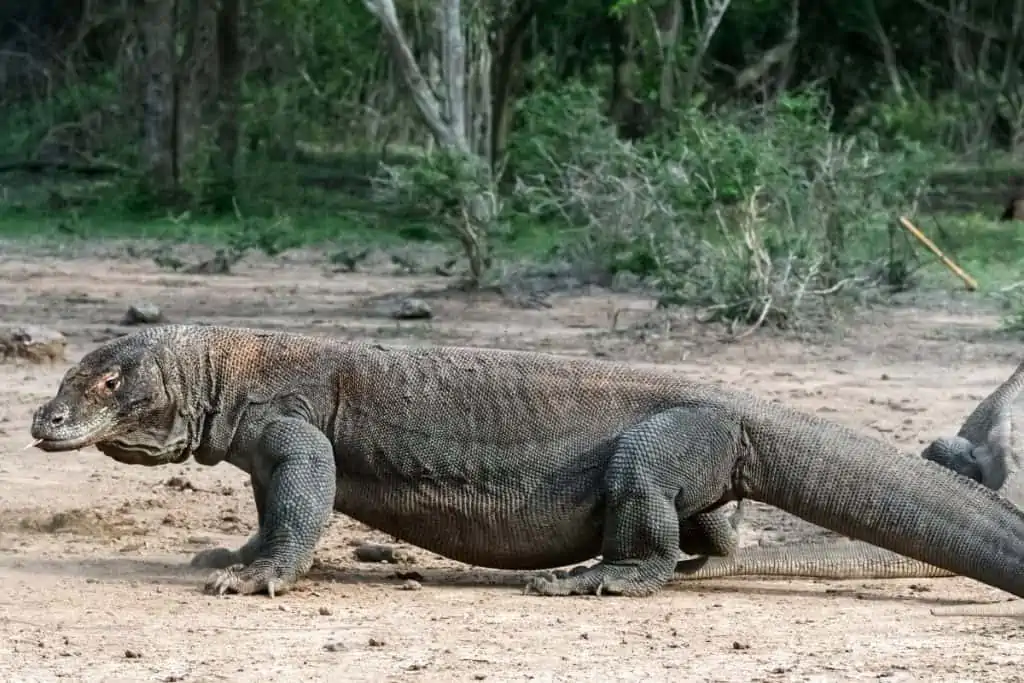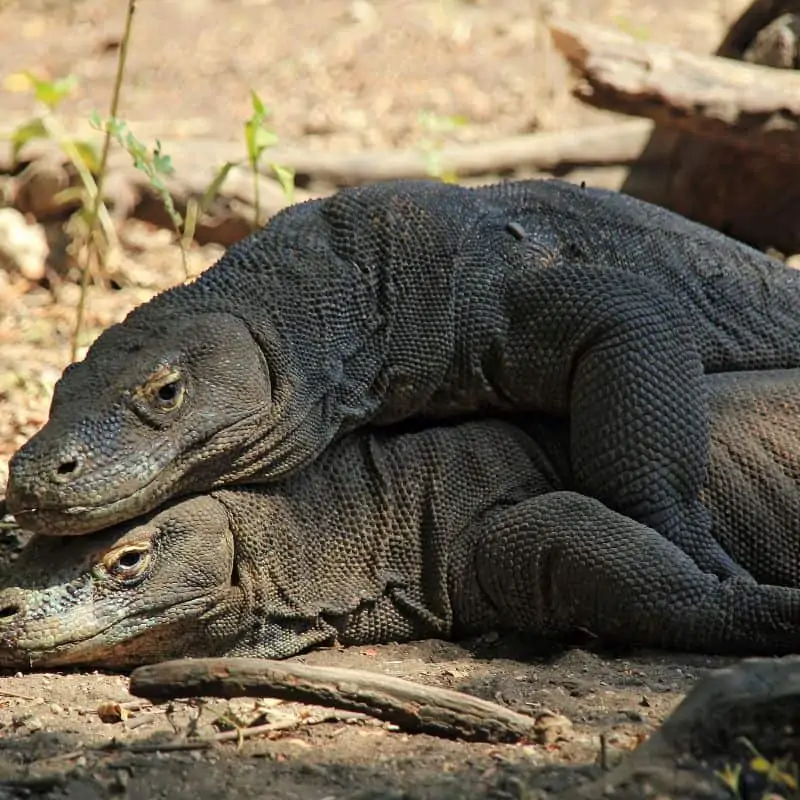Komodo Dragons are the largest living lizards in the world, so how much do Komodo dragons weigh to have earned this title?
Komodo dragons weigh up to 70 kilograms or 150 Pounds. Due to their colossal size, the Komodo dragons are considered apex predators – having two glands in their lower jaw to secrete venom inside the bodies of their prey.
These massive predators are known for their size, so let’s look further.

Komodo Dragon Weight As They Age
The weight of all animals changes from birth till usually their maturity, and Komodo Dragons go through the same increase in weight.
Young Komodo Dragons (Up to 100 Grams)
A baby Komodo takes a similar period of nine months to hatch out from its eggs, just like humans.
A newborn Komodo dragon, known as a “Hatchling,” weighs up to 100 grams, while the average length of these lizards is 16 inches.
Being so small helps them survive by climbing trees to escape predators.
At the age of 5, the average weight of a Komodo dragon is said to be 25 kilograms, or 55 pounds, while the length is around 2 meters.

Adult Komodo Dragons (150-300 Pounds)
A young Komodo dragon may take up to a decade to reach maturity, while the average life expectancy ranges around 30 years.
When these lizards become fully grown – they can weigh as much as 140 kilograms or 300 pounds. However, the average weight of a mature Komodo dragon is around 70 kilograms or 150 pounds.
The highest recorded weight of a fully-grown Komodo dragon is said to be a whopping 366 pounds or 166 kilograms.
The average male Komodo dragon may weigh anywhere between 79 to 91 kilograms.
Females, on the other hand – can weigh anywhere between 68 to 73 kilograms.
Diet Of A Komodo Dragon
Komodo dragons can rely on almost any diet, such as birds, mammals, and other similar species, and smell their prey from as far as 2.5 miles or 4 kilometers.
Although they can travel at a rate of 20 Kmph – they heavily rely on their patience to hunt down their prey. Once the target is in sight, the Komodo dragons stick their jaws inside the prey.
However, if the prey manages somehow to free itself from the deadly lock of the dragon, the venom present in a Komodo’s saliva does its job to slow down and eventually kill the prey by producing an infection – making it easier for the dragons to catch up, and bring the prey back to their habitat.
The heavy weight of these dragons also contributes to their diet. The largest lizard species can manage to eat 80 percent of the body weight of their prey – that too, in a single feeding.
Mating Season for Komodo Dragons
The mating season for the Komodo dragons begins between May and August. The soon-to-be mother takes excellent care of her eggs for several weeks until September – when the time to lay eggs begins.
Due to their heavy weight and large size, female Komodos provide a significant advantage to the specie’s population. Being able to carry 15 to 30 eggs during a single pregnancy period, the female Komodo dragon lays 24 eggs on average – per pregnancy.
The female Komodos are also highly selective about where they can lay their eggs; due to this particular reason, they dig several holes in the ground before laying their eggs inside one.
The eggs are kept deep into the ground, about 2 meters, to ensure perfect environmental conditions.
A female Komodo may also resort to bird nests, preferably of Megapode birds. This shortcut helps them save time and energy.
Since the size of a full-grown Komodo dragon is insanely large, you might expect them to lay large eggs as well, compared to the size of other animal species. But in reality, the eggs are only twice the size of a chicken egg.

Final Thoughts On Komodo Dragon Weight
The Komodo dragons, or Komodo monitors, are known to be the largest surviving species of lizards, having the ability to weigh as much as 70 kilograms.
The male version of these lizards can weigh between 79 to 91 kilograms, while the female Komodos can weigh between 68 to 72 kilograms.
Their heavy weight puts them at a great advantage, especially regarding diet and reproduction.
However, due to recent environmental, human, and reproductive factors – the species have now been considered “endangered.”
FAQs
Do Komodo Dragons Still Exist?
Komodo Dragons still exist but have become endangered due to recent human activities and other environmental factors. Also, since the vertebrates can reproduce asexually, this contributes to the cause as well – since asexual reproduction in female Komodos produces only male offspring, leading to a lesser amount of female Komodos.
What Is the Heaviest Komodo Dragon?
Komodo dragons are the largest surviving species of lizards. Male Komodos can weigh between 79 to 91 kilograms, while females can weigh up to 68 to 72 kilograms. The heaviest recorded weight of a Komodo dragon was 166 kilograms or 366 pounds.
Can Komodo Dragons Reproduce Asexually?
Komodo dragons are one of the few species of vertebrates that can reproduce asexually. This ability gives them significant advantages over other vertebrates. However, it has a significant drawback as well – asexual reproduction produces male offspring. This can lead to a lower ratio of female Komodos and decreased sexual reproduction, eventually leading to endangerment.

